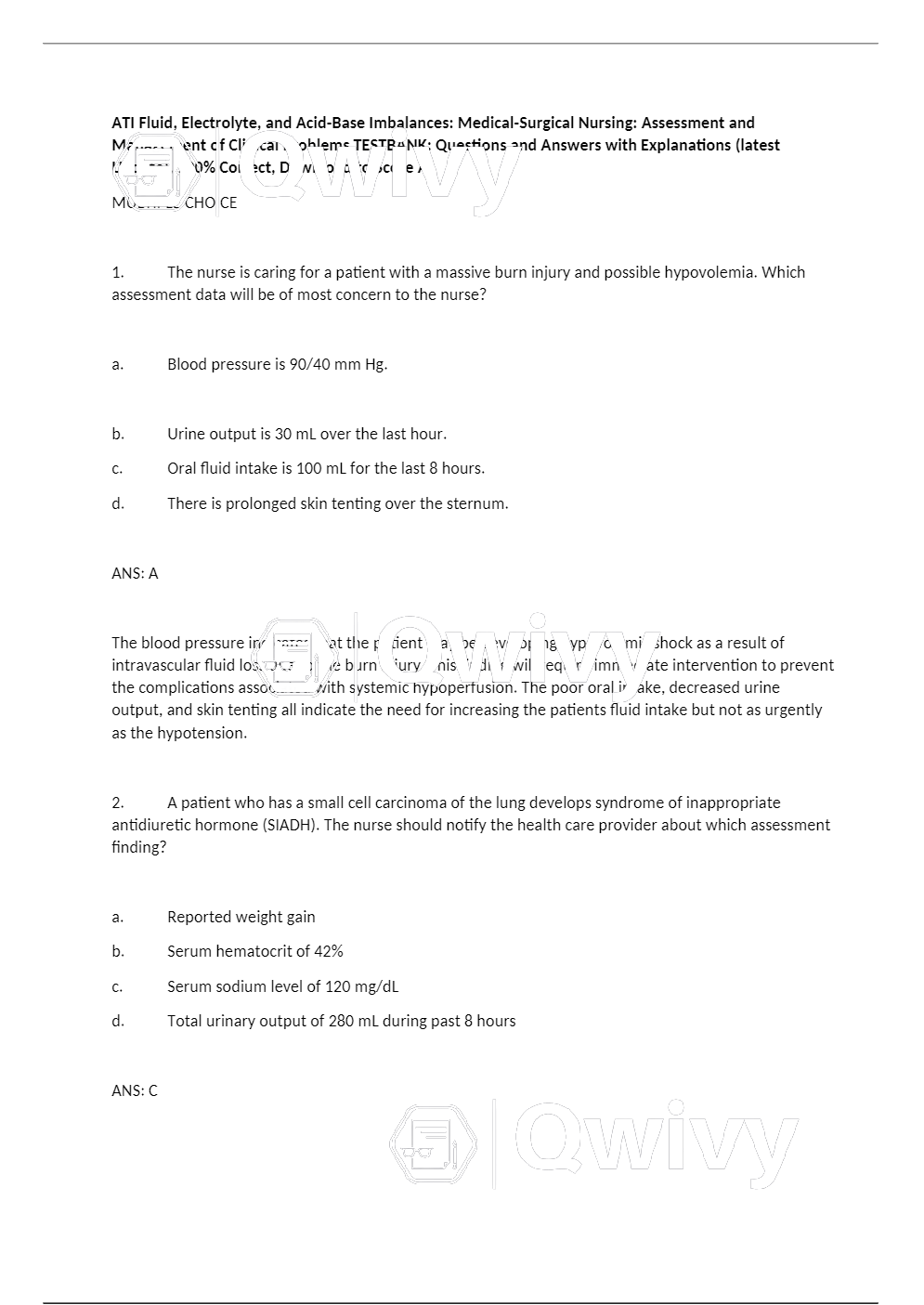
MULTIPLE CHOICE
1. The nurse is planning care for an older client who has
very thin skin on the backs of the hands and arms. What is the client’s
priority problem?
a. Risk for
injury
b. Infection
c. Poor
self-image
d. Discomfort
ANS: A
Thinning skin, with decreased attachment between the dermis
and the epidermis, is at increased risk for injury in response to even minimal trauma
or shearing events. If injury occurred, infection would be a possible problem.
Thin skin should not cause discomfort. Poor self-image does not take priority
over the risk for injury.
DIF: Cognitive Level: Application/Applying or higher REF:
N/A
TOP: Client Needs Category: Health Promotion and Maintenance
(Aging Process)
MSC: Integrated Process: Nursing Process (Planning)
2. A client has a suspected superficial fungal infection.
The nurse prepares the client for a culture by explaining the procedure. Which
statement by the client indicates a correct understanding of the procedure?
a. “The
doctor will shave off a small piece of the lesion.”
b. “You will
be performing what is called a punch biopsy.”
c. “A
sample is obtained by simply scraping the lesion.”
d. “You’ll
squeeze material from the lesion to send to the laboratory.”
ANS: C
A superficial fungal culture is obtained by gently scraping
the lesion with a tongue blade. The other techniques are not used for a
suspected superficial fungal infection.
DIF: Cognitive Level: Application/Applying or higher REF:
N/A
TOP: Client Needs Category: Physiological Integrity
(Reduction of Risk Potential—Diagnostic Tests) MSC: Integrated Process:
Teaching/Learning
3. The nurse observes yellow-tinged sclera on a client with
dark skin. Based on this observation, what is the nurse’s best action?
a. Evaluate
the client further for hepatitis.
b. Examine
the soles of the client’s feet.
c. Inspect
the client’s oral mucosa.
d. Place the
client in contact isolation.
ANS: C
The nurse can best observe jaundice in clients with dark
skin by inspecting the oral mucosa, especially the hard palate, for yellow
discoloration. Sclera may have subconjunctival fat deposits that show a yellow
hue. Before considering hepatitis, the nurse must do a more thorough
assessment. The soles of the feet may appear yellow simply from calluses, so
this is not the best place to assess. No need to isolate the client has been
identified.
DIF: Cognitive Level: Application/Applying or higher REF:
N/A
TOP: Client Needs Category: Health Promotion and Maintenance
(Techniques of Physical Assessment) MSC: Integrated Process: Nursing Process
(Assessment)
4. A client has a bluish tinge to the palms, soles, and
conjunctivae. Based on these assessment data, what does the nurse do next?
a. Take a
medication history.
b. Assess
pulse oximetry.
c. Assess
the client’s personal hygiene.
d. Palpate
the soles and palms.
ANS: B
Cyanosis can be present when impaired gas exchange occurs.
In a client with dark skin, cyanosis can be seen because the palms, soles, and
conjunctivae have a bluish tinge. The nurse should assess for systemic
oxygenation before continuing with other assessments.
DIF: Cognitive Level: Application/Applying or higher REF:
N/A
TOP: Client Needs Category: Physiological Integrity
(Reduction of Risk Potential—System-Specific Assessments) MSC: Integrated
Process: Nursing Process (Assessment)
5. An older client with age spots is fearful of contracting
skin cancer but wants to continue his hobby of outdoor gardening. Which
statement by the client indicates a good understanding of the teaching about
this issue?
a. “I will
avoid staying outside during the day.”
b. “I can
use only oil-based tanning lotion.”
c. “I have
to start growing plants indoors.”
d. “I will
wear a hat and gloves when gardening.”
ANS: D
Freckles, birthmarks, and age spots are caused by patches of
melanin in the skin. Melanin protects against the harmful effects of sun
exposure. Hyperpigmentation can occur in sun-exposed areas and can lead to skin
cancer. For clients who spend time outdoors, the best protection from skin
cancer is decreasing the amount of skin exposed to sunlight.
DIF: Cognitive Level: Application/Applying or higher REF:
N/A
TOP: Client Needs Category: Health Promotion and Maintenance
(Self-Care)
MSC: Integrated Process: Teaching/Learning
6. An older client expresses concern about developing new
“age spots.” Which instruction is most important for the nurse to provide to
the client?
a. “Limit
the time you spend in the sun.”
b. “Monitor
for signs of infection.”
c. “Monitor
spots for color change.”
d. “Use skin
creams to prevent drying.”
ANS: C
The ABCDE method (check for asymmetry, border irregularity,
color variation, diameter, and evolving [changing] in any feature) should be
used to assess lesions for signs associated with cancer. Any positive finding
using this method requires the lesion to be examined by a dermatologist or a
surgeon. The other options are good instructions for clients too, but this
client is worried about lesions that are already present.
DIF: Cognitive Level: Application/Applying or higher REF:
N/A
TOP: Client Needs Category: Health Promotion and Maintenance
(Self-Care)
MSC: Integrated Process: Nursing Process (Implementation)
7. A client is seen in the clinic for a persistent hand
rash. When taking the client’s history, the nurse places priority on obtaining
information related to which topic?
a. Age
b. Gender
c. Occupation
and hobbies
d. Socioeconomic
status
ANS: C
The location of the rash suggests contact dermatitis. This
condition is most often caused by contact with irritating substances such as
might be found in industrial settings or associated with specific hobbies.
Socioeconomic status may be related to the rash, particularly if it is
associated with poor hygiene, but age and gender are not related to rashes.
DIF: Cognitive Level: Application/Applying or higher REF:
N/A
TOP: Client Needs Category: Physiological Integrity
(Reduction of Risk Potential—System-Specific Assessments) MSC: Integrated
Process: Nursing Process (Assessment)
| Category | ATI |
| Release date | 2021-09-14 |
| Pages | 8 |
| Language | English |
| Comments | 0 |
| Sales | 0 |






{{ userMessage }}





